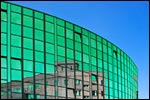
Contrary to popular belief, most developers don’t bulldoze Bambi solely to satisfy their innate avarice. Instead, they pave the Earth at the bidding of their clients — by which I mean lenders and investors, not homebuyers, office tenants, or other such "end users." Regardless of how exciting and cool a development proposal is, it just won’t happen if some faceless banker doesn’t advance a big pile of cash.
As rapacious national banks swallow smaller, local competitors by the dozen, these lending decisions have increasingly fallen to bankers blindly applying generic guidelines. The result: a paint-by-numbers landscape of interchangeable (but financially safe) subdivisions, strip malls, and office parks. Any developer who dared to innovate would have to do so on his own dime — and sure enough, many pioneering examples of New Urbanism have been backed by "nontraditional" investors like old-money families, large corporations (like Microsoft, Disney, EDS, and Ebsco), and even charitable foundations. Despite growing interest in socially responsible investing, few investors have thought of how to clean up the picture in the building industry — source of, say some, half of America’s greenhouse gas emissions.
Now, Philip Langdon of New Urban News reports on a new generation of private-equity investment funds that have started up to match socially responsible real estate investors and leading-edge developers. Green developer extraordinaire Jonathan Rose of New York sees his new $100 million fund as an investor alternative to "buying stocks in REITs [Real Estate Investment Trusts, publicly traded corporations whose primary business is real estate] which are based on sprawl." Perhaps the most promising is the $100 million Green Living Fund, based in Santa Cruz and launched by Kacey Fitzpatrick:
Fitzpatrick, cofounder and vice president of sustainability at the Green Living Fund, said her pool is the result of a desire "to promote the right kind of development." She observes: "Our goal is to promote the creation of vibrant, pedestrian-oriented, walkable communities with a mix of uses and a mix of housing types and incomes. Transit is a key piece of what we are doing." The fund will use "the LEED [Leadership in Energy and Environmental Design] standards for Neighborhood Development as the criteria for our initial assessment of a location," she says. Buildings will have to qualify for at least a LEED-Silver designation.
Whereas Rose hopes to raise funds from private and nonprofit investors, Fitzpatrick (an architect by training who hopes to make a bigger impact) hopes to gain substantial funding from public pension funds. If these funds successfully quantify the financial benefits of investing in green development, they could attract more investment, thereby mainstreaming now-unconventional forms of development.
I often liken the process of changing the way America builds cities to turning around a giant ship; many will be frustrated with the slow pace, but taking a trillion-dollar industry optimized to efficiently turn forests and fields into sprawl at the rate of five acres a minute means a lot of change. If investors — the ones paying for the bulldozers — catch on, we can count on those bulldozers being used far more gently in the future.


